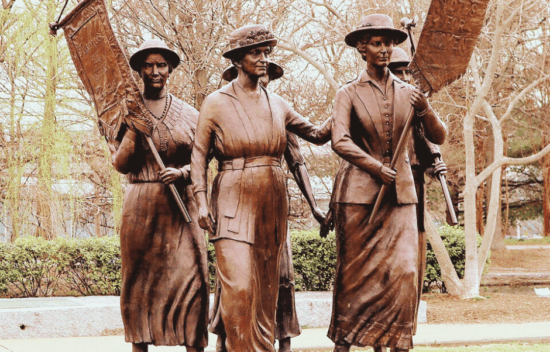
Interactive Suffrage Timeline Lesson Plan
Guiding Questions
- How did democratic participation expand in the United States?
Objectives
- Students will place major suffrage events on a collaborative timeline.
- Students will classify the events as expanding or restricting voting rights.
Student Resources:
Teacher Resources:
- Interactive Timeline of Suffrage Teacher Resource, printed and cut
- Sticky notes or markers
- Long butcher paper, string, or another method to create a physical timeline across a classroom wall
- (Optional Extension) Pre-made “event cards” with suffrage-related events (or students can create them)
Anticipate
- Glossary terms: Terms used in this lesson for pre-teach opportunities or vocabulary support:
- suffrage, property-owner, amendment, progressivism
- Before class begins, create a wall timeline with four major sections:
- Early Republic
- Early Nineteenth century
- Reconstruction
- Post-World War II
Teacher note: Flex the timeline format to fit your classroom. Clothes pins on a string, magnets on a whiteboard, or sticky tack on a blank wall all work well.
Engage
Two Truths and a Lie
- Share three statements and ask students to guess which one is the lie:
- Some states have laws that remove voting rights from people convicted of certain crimes.
- Every adult citizen in the U.S. has always had the right to vote.
- Federal and state governments share responsibility for setting voting eligibility standards.
- Correct answer: #2 is the lie.
- Use this to launch into a short explanation: “As we’ll see today, the right to vote hasn’t always been guaranteed-or permanent. Let’s look at how it’s been gained, lost, and changed over time.”
Explore
Timeline Creation:
- Each student or pair receives a piece of the Timeline of Suffrage.
- There are era titles, descriptions, images, and primary sources in the document with 16 pieces for students to work with (excluding era labels).
- Students analyze their piece of the timeline briefly (or research if needed,) then:
- Place it on the class timeline in the correct area.
- Classify it as expansion or restriction using color-coding.
- Use a color-coding system that works for your classroom, depending on the timeline method you chose.
- For example: If using a clothes pin timeline, you could have two different colored pins for students to use. Red for restriction and green for expansion.
- Add a sticky note explaining who was affected and how.
Gallery Walk and Analysis:
- Students circulate and view the full timeline.
- On their handout, they note:
- Two major expansions
- Two major restrictions
- One event that surprised them
- A pattern they noticed across time
Optional Activity: Additional discussion questions
- Were there moments of progress followed by setbacks?
- Who benefited most from expansions? Who suffered most from restrictions?
- How is the principle of consent of the governed related to the right to vote?
- Consent of the Governed means: The power of government comes from the people.
Assess & Reflect
- Written Response:
- Write a paragraph to respond to the statement “Has expanding suffrage increased representation and consent for all?”
- Support it with 2-3 pieces of evidence from the timeline.
- Write a paragraph to respond to the statement “Has expanding suffrage increased representation and consent for all?”
AND/OR
- Concept Map
- Create as an example a concept map (or bubble map) on the board as an example for students.
- Many examples of concept maps exist online. A simple example concept map could group school lunch options by days of the week, or animals by type.
- Ask students to create their own concept map using keywords from the suffrage interactive timeline.
- For example: The center circle may say “suffrage.” Circles around it radiating out might say, “women” “black men” “18 to 20-year-olds” and “people that don’t own property.” Each of those circles might have additional circles radiating out from them listing primary sources or eras in which each group gained suffrage.
- Create as an example a concept map (or bubble map) on the board as an example for students.
Extend (Optional)
- Prepare event cards (or let students research/create them), such as:
- 1790 Naturalization Act
- Jacksonian-era voting reforms
- Fifteenth Amendment
- Poll taxes/literacy tests
- Nineteenth Amendment
- Indian Citizenship Act
- Voting Rights Act
- Shelby v. Holder (2013)
- Voter ID laws
- Have students add the events they have researched to the interactive timeline.